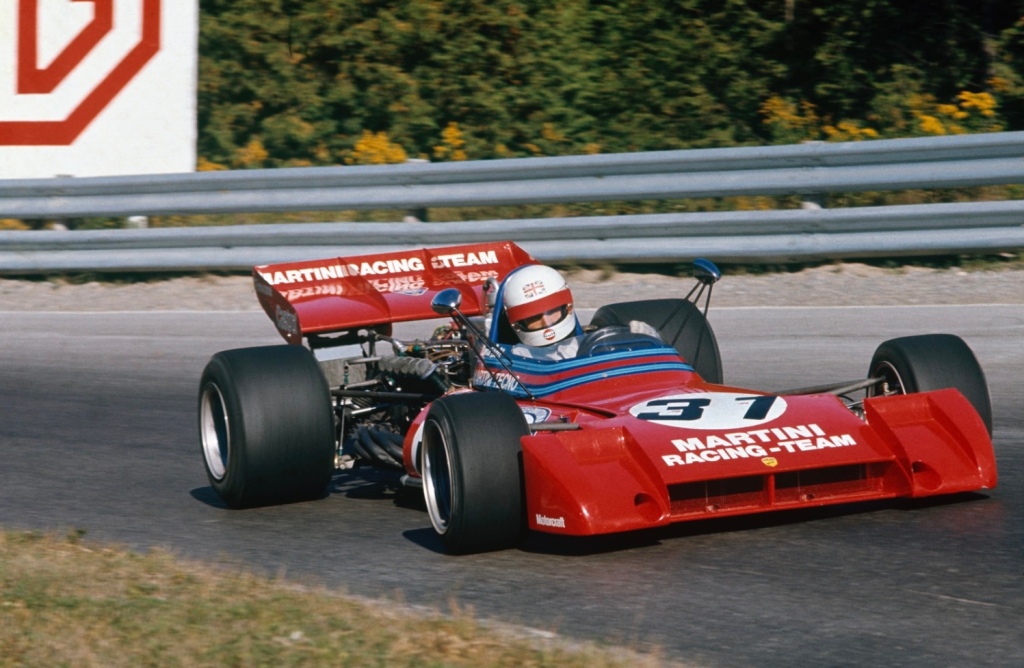
Only one of hundreds of Kart manufacturers made it to F1. Tecno had won Kart, F3 and F2 championships before they leapt into Grand Prix racing in 1972 but the venture failed dismally after only 10 grand prix starts thanks to Ferrari-esque levels of intrigue and infighting.
Bolognese engineers Luciano and Gianfranco Pederzani ran a successful truck hydraulics business named Oleodinamica Pederzani & Zini which was inspired by the technology in American trucks they saw post-war. Another American idea they rather liked was Karts!



Tecno Kart operated from premises in Via Bufalini, Borgo Panigale, Bologna from 1962. Tecno were the first to volume produce ‘sidewinder’ chassis to take advantage of the newly developed Parilla air-cooled, rotary-valve motors.
These Parilla GP15L powered Tecno Kaimono’s (the caiman is a small alligator, the reptile featured on the Tecno logo) won the World Kart championship three times on the trot from 1964-66. Ex-Italian GP motorcyclist Guido Sala was victorious in 1964-65, then Susanna Raganelli won in 1966 after a furious battle with a couple of Swedes, Leif Engstrom and Ronnie Peterson.
Tecno put a toe in the water with Formula 250 cars in 1964, then Formula 850 machines in 1966, before building their first F3 car in 1966.


Tecno Automobili’s kart inspired, wide-track, short wheelbase TF66 debuted with Carlo Facetti at the wheel at the Circuito del Mugello on July 17. Two laps of a challenging 66km road course through the Tuscan countryside was a good test for the new chassis! In a good start for the marque, he finished fourth, Jonathan Williams was up front in a De Sanctis Ford.
Other early Tecno F3 pilots included Grand Prix winner, Giancarlo Baghetti, Chris Craft, Mauro Nesti and Tino Brambilla. Tecno’s breakthrough win came when Brambilla’s TF67 Ford won the Luigi Musso Trophy at Vallelunga in October 1967. Clay Regazzoni’s TF67 Ford Novamotor took the honours in the more prestigious GP Espana, Jarama, a month later.
After a modest start in 1967, Tecno sold 40 cars in 1968, commencing a great run of F3 success. They won the Italian championship from 1968-71, three French titles from 1968-1970 (Francois Cevert in 1968), not to forget Swedish titles for Reine Wisell and Ronnie Peterson in 1968-69.
Tecnos were quick at Monaco too, with wins for Jean-Pierre Jaussaud and Ronnie Peterson in 1968-69, and in Switzerland where they won championships in 1969 and 1972.


Luciano Pederzani adapted his Tecno 68 design to F2 specifications by adding bigger brakes, a five-speed Hewland FT200 transaxle and 210bhp Ford FVA 1.6-litre engine. 1968 works cars were raced by Regazzoni, Jaussaud and Facetti. Regga’s sixth place in the European championship was the best of the Tecnos which included Ron Harris entered cars for such notables as Pedro Rodriguez, Richard Attwood and Jonathan Williams.
Cevert and Nanni Galli raced the works F2s in 1969, with Francois taking Tecno’s maiden F2 victory in the GP de Reims in June. Cevert was third in the championship and Galli seventh in a year the Bologna boys built 60 F2 and F3 spaceframe chassis.
The bring-home-the-bacon (pancetta actually) year was in 1970 when Clay Regazzoni won the Euro F2 title with victories in four of the eight rounds, with Cevert sixth. That year both Tecno men made their F1 debuts, Regazzoni with Ferrari and Cevert with Team Tyrrell.
For 1971 the Pederzani’s secured Elf sponsorship but Equipe Tecno Elf had a lean time despite the best efforts of Cevert, Jean-Pierre Jabouille and Patrick Depailler, all of them rather handy Grand Prix pilots of the future.



For 1972 the Pederzanis, confident in their own abilities, decided to take the giant leap into Grand Prix racing.
Not for them the garagista path either, purchase of a Ford Cosworth DFV 3-litre V8 would have been too easy, after all, they had been fitting Ford Cosworth FVAs into their F2 cars for three years!
They decided to build the chassis and engine, both of which had more than a nod to Ferrari practice.
Luciano Pederzani, Renato Armoroli – recruited from Ducati just down the road in 1968 – and other technicians commenced work on Project 123 (12-cylinders, 3-litres) a twin-cam, four valve, fuel injected a 180 degree 3-litre flat-12 in early 1971.
To shorten development time the team adopted the familiar bore and stroke ratio of Ford/Cosworth’s 1-litre F3 engines – 80.98x48mm – which resulted in a displacement of 2960cc, later tickled up to 2995cc by a small increase in stroke.
By early 1972 the first way-too-heavy (205kg, 40 more than a Cosworth DFV) engines were on the dyno, the best result after early fettling was a claimed 402bhp @ 11,000rpm.
Tecno hired Parma born engineer Giuseppe Bocchi from Ferrari, where he had been working on engine structural stiffness and vibrations. Bocchi redesigned the Tecno engine to incorporate four main bearings, rather than its original seven – just like Ferrari’s flat-12 – making the structure lighter and stiff enough to be used as a structural chassis member.


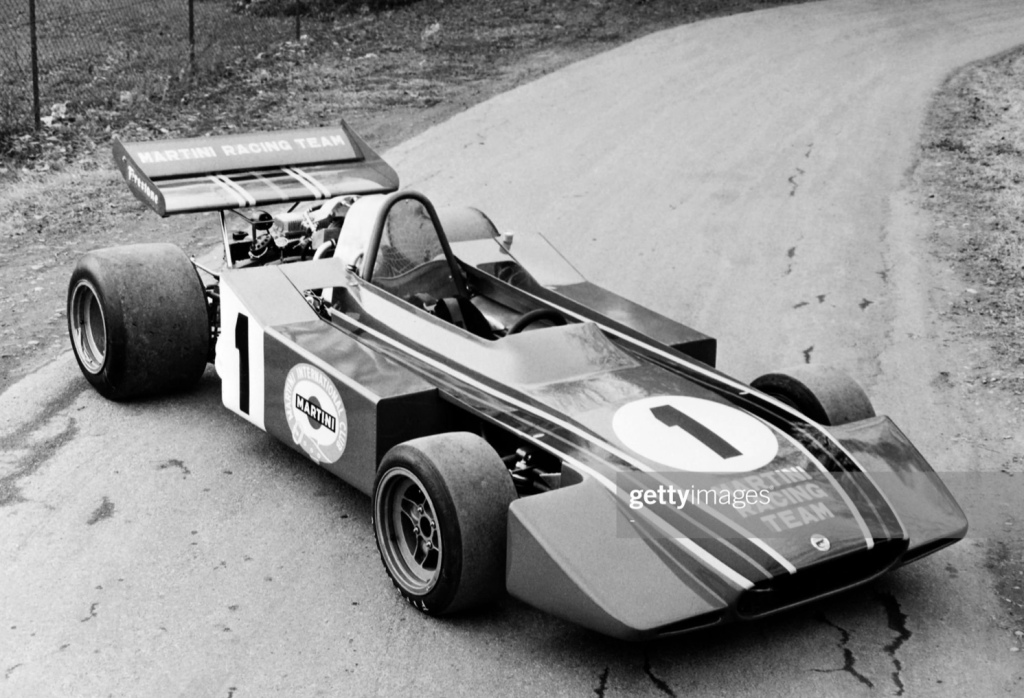
While progressing the engine, the team also turned their attention to a narrow track, short wheelbase chassis based on existing F2 practice; at 2270mm it was 120mm shorter than the Ferrari 312B.
Tecno’s first monocoque chassis was designated PA123 (Pederzani Automobili- 12 cylinders-3-litres) and followed Ferrari Aero practice. It comprised aluminium sheets rivetted and glued to a light-gauge tubular frame. While side radiators were planned, the engines voracious appetite for coolant resulted in a large front radiator, and bluff-nose of the type Tyrrell popularised in 1971.
Martini and Rossi’s spectacular livery had adorned Porsche Salzburg 908s and 917’s in 1971, but with the end of the fabulous 5-litre sportscar era their sponsorship was destined for Tecno’s GP racing adventure.
Upon John Wyer’s suggestion, Count Gregorio Rossi engaged the now out of work, very well credentialled JW Automotive Team Manager, David Yorke, as motor racing consultant for Martini & Rossi International to replace Hans-Dieter Dechent.

Initially it appeared the M&R money was destined for Brabham, a home it found in 1975. Derek Bell had been offered a Brabham drive, but ultimately Tecno got the lire, their nominated team were drivers Nanni Galli and Bell with Yorke as team manager.
Predictably, despite track tests in December 1971, the complexity of building the car’s core components in-house ensured the Tecno PA123 ran late. Derek Bell expressed his admiration for Tecno about that first test to MotorSport all the same.
“Finally, we (Bell and Yorke) got the call to fly to Italy. We arrived at Pirelli’s test track to find a delegation from the Rossi family but no car. First, I was hoping it wouldn’t show and, when it did, that it wouldn’t start. I’m convinced that if Tecno had had a disaster that day, I would have been off to Brabham. It was an icy cold day and the team poured hot water in the engine, fired it up and it ran and ran. We couldn’t believe it. David had to concede that it was a remarkable showing for a first test.”
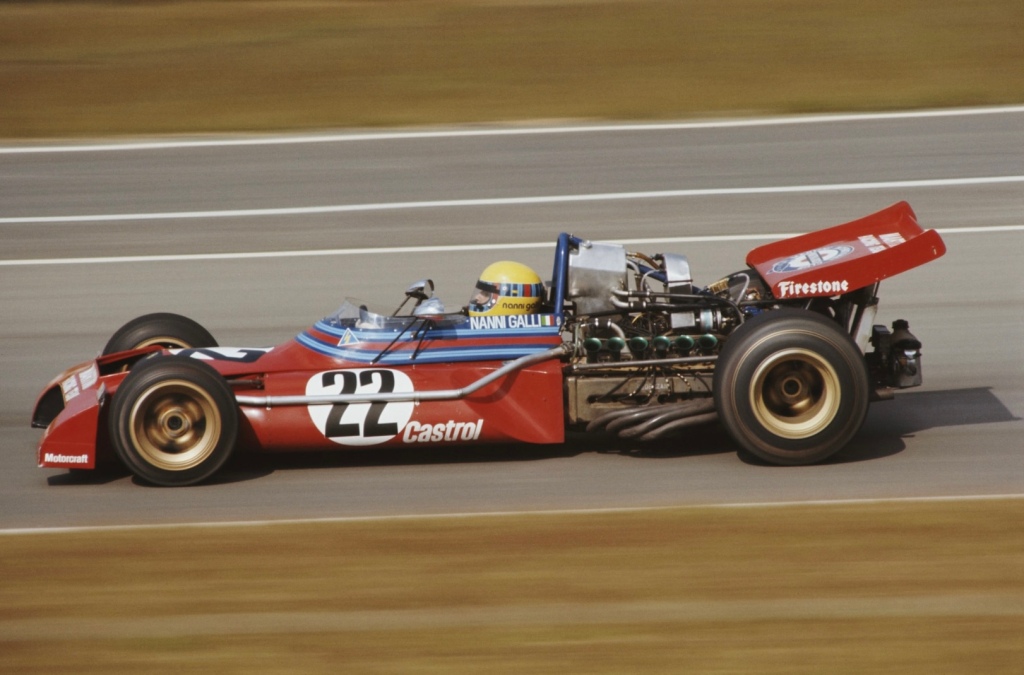
The car took its public bow during the Belgian GP weekend at Nivelles (above), the fifth round of the 1972 championship ultimately won by Emerson Fittipaldi’s Lotus 72D Ford.


PA123/1 impressed the masses with its sound if not its speed. Galli qualified second last but ran reliably until spinning and taking out Tecno compatriot, Clay Regazzoni’s Ferrari. The Tecno was written off in the process.
The team next contested the non-championship Gran Premio della Republica Italiana at Vallelunga in mid-June. Galli finished third aboard a new car, PA123-2, in a performance which cheered the team despite the machine being way off the pace in a small, but reasonably classy eight car grid.

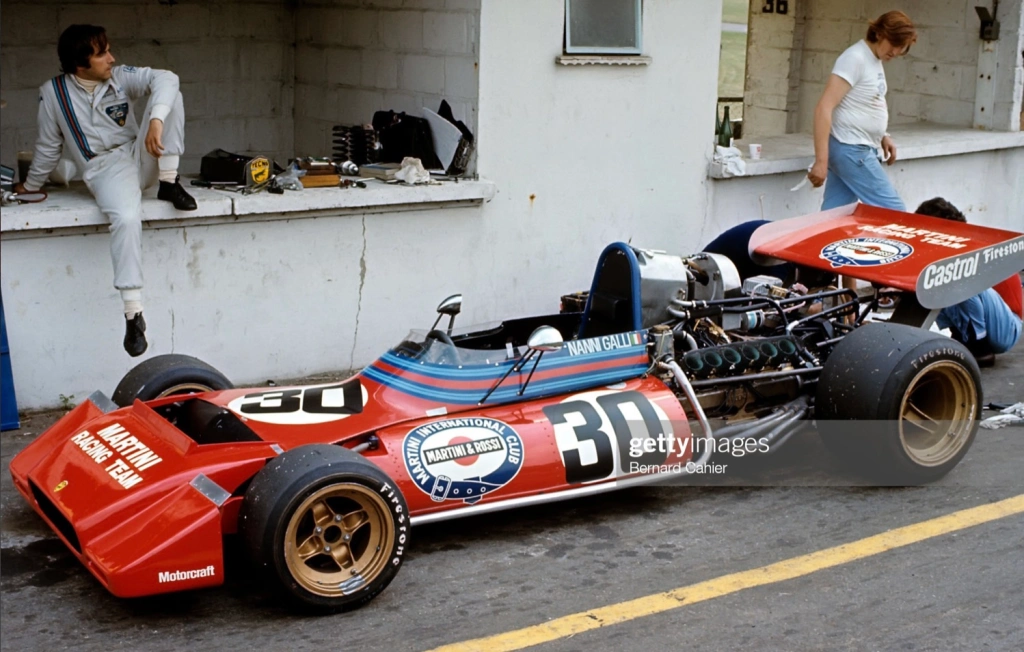

Bell had his first race drive in that car at Clermont Ferrand but got no further than practice. Four of the nine bolts attaching the engine to the rear chassis bulkhead had cracked from the engine’s massive vibrations, somewhat impairing the car’s handling. Good Vibrations they were not.
Galli was entered at Brands Hatch where PA123-2 appeared with a new rear suspension cross-member which mounted the coil spring/dampers more conventionally (mounted less vertically) on the advice of Ron Tauranac.
Tauranac was freelancing having sold Motor Racing Developments, and later left them, he was marginalised and short-paid by Bernard Charles Ecclestone.
Nanni qualified the car 18th on the 27-car grid, not bad at all given its shortage of power and surfeit of weight on this technically demanding circuit.
The Tecno 123 never gave more than 420/430bhp, 20 and 60 less than the contemporary DFV and Ferrari, while the car weighed 640kg, far more than the 550kg Ferrari 312B2, 540kg Tyrrell 003 Ford and 575kg McLaren M23 Ford.
The relative practice performance was ruined by an accident on lap 10 of the race.
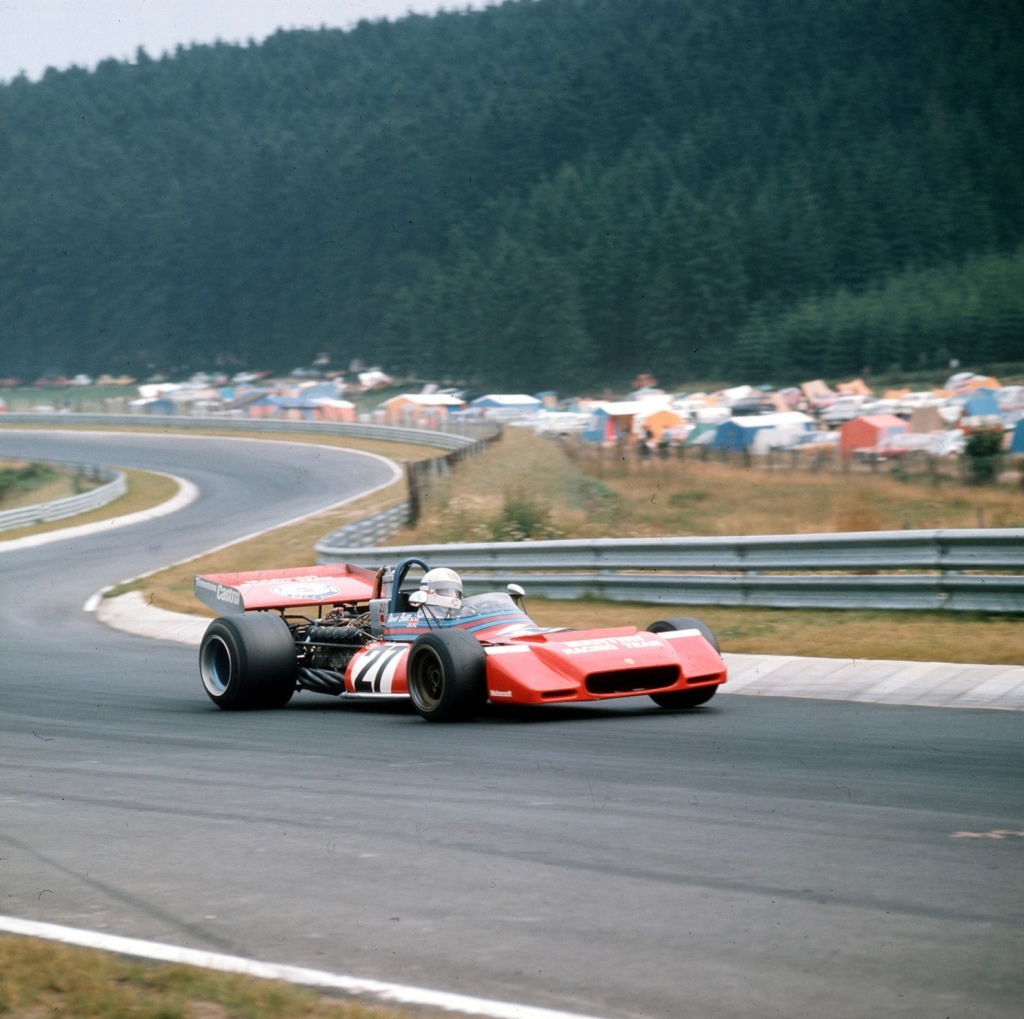


Bell was the more experienced Ring racer and took the wheel of PA123-2 in Germany. The car was further modified with wider front track and revisions to the oil tank. Derek was Q25 of 27 but out after only four laps with valve failure. Up front, the other flat-12 car, a 312B2 driven by Ickx won from pole.
Back in Bologna, Pederzani and his team wrestled with engine vibrations and lubrication issues in the same way Mauro Forghieri struggled to stop his flat-12 breaking its crankshafts early in its late 1969 life; seemingly insurmountable problems which resulted in Chris Amon leaving Ferrari…
Off to Austria, Galli qualified Q23 of 36 but 3.5 seconds adrift of winner/poleman Fittipaldi’s fastest Lotus 72 practice time. This time the Tecno finished the race with invaluable race mileage, albeit an unclassified 17th nine laps adrift of Emerson. Tecno had such a climb to make!
There was plenty of pressure too, with unhappy drivers, sponsors and Bologna technicians. The team’s home event at Monza was next. Armaroli left in frustration, believing the engine unreliability was due to inexperienced engine fitters at base and among the race team members.



Two cars were entered in Italy. A new machine, chassis PA123-5 (sic-what happened to chassis 3 and 4?) with neater front suspension and Matra-like nose for Galli, alongside PA123-2 for Bell.
With Fittipaldi again up front, Galli was Q23, while poor Derek didn’t make the cut. Worse still, in front of their home crowd – Galli’s, the Pederzani’s and Rossi’s – the car only completed 6-laps before, you guessed it, the engine failed.
The Martini Racing Team took the new car to North America for Bell to race, but it wasn’t a happy trip with Derek crashing on the warm up lap at Mosport from Q25, last on the grid.
On the fast, technically challenging Watkins Glen track in upstate New York, Derek was Q30 of 32, seven seconds adrift of Jackie Stewart’s Tyrrell 005 Ford pole. Again, the Tecno’s engine went pop, this time after 8 laps.
At best the year was a character building one, in reality it was a clusterfuck of some scale which got a whole lot worse in 1973.
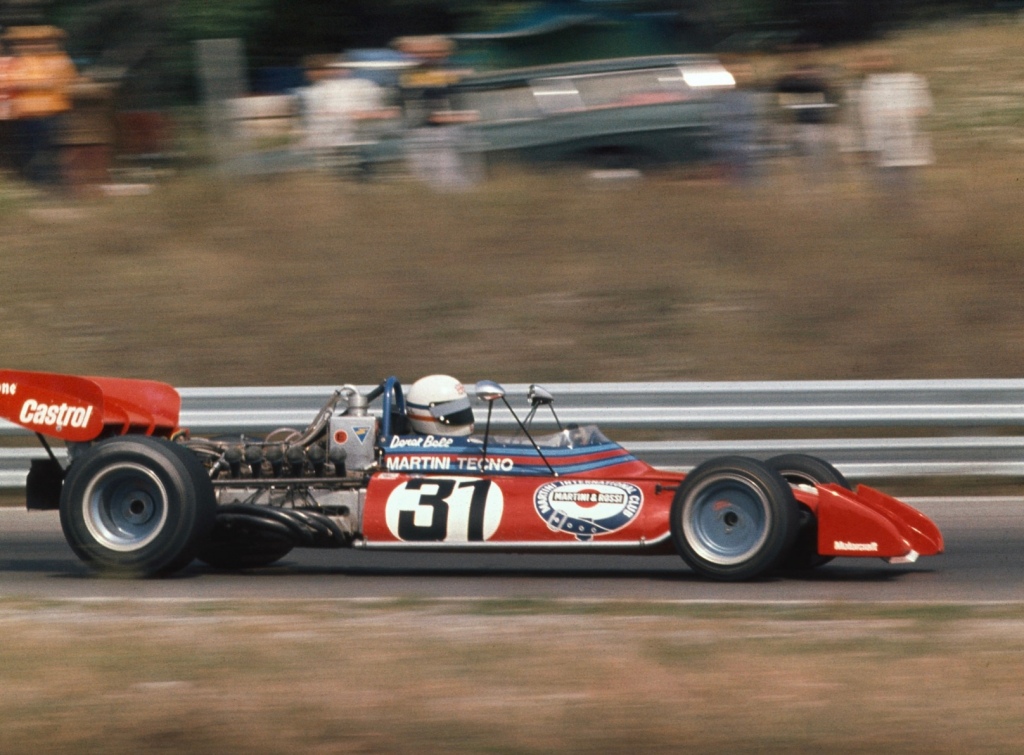


In a perfect world the plan for 1973 should have been obvious. Race one DFV powered Tecno while continuing to develop the flat-12 until it was competitive. That way the team would have gained valuable miles to develop the chassis while getting the engine to required levels of power and endurance.
Of course, sound decisions are only possible if all parties in a business cooperate and communicate; the Pederzanis, Rossis and Yorke. Clearly, they were not, despite that, to their credit, Martini & Rossi saddled up for another year.
Instead of commonsense – the chain of events differs depending upon your source – Yorke convinced the Rossi’s to back a plan involving him constructing a car in the UK.
For reasons Yorke never disclosed, he engaged his friend, Gordon Fowell’s Goral Engineering to design a car which was fabricated by John Thompson’s respected Northhampton firm. Professor Tim Boyce, also working with McLaren at the time, provided advice on aerodynamics.
Fowell’s design credentials then were entirely outside racing. His involvement in motorsport was as an amateur driver and partner to journalist Alan Phillips in a company which produced audio tapes of race engines. Goral was their latest venture.

David Christopher Yorke was a war-hero. He became an RAF Flying Officer (#37059) in 1937 and was twice awarded the Distinguished Service Order for bravery during the Battle of France. The first was for carrying out low-level reconnaissance on German positions in a Gloster despite heavy anti-aircraft fire, the second was a similar act which involved dropping supplies to beleaguered troops in Calais. The award of Flight Lieutenant Yorke’s Distinguished Flying Cross was recorded in The London Gazette on July 23, 1940.
He then flew Hurricanes in The Battle of Britain before being posted to India as a Squadron Leader in 1941. By the end of the David Yorke was serving as a Group Captain in the Far East.
He remained with the RAF post-war but in 1949 accompanied another former RAF officer, Peter Whitehead to the Czech Grand Prix. Whitehead won the race in his Ferrari 125 and offered Yorke the role of team manager, he commenced in 1950. Success with Whitehead, Vanwall, Aston Martin and JW Automotive followed in the succeeding two decades.
This extraordinary man was described in one of his medal recommendations as a “commander and organiser of exceptional merit.” In this case, however, he was most cavalier with Martini & Rossi’s money, his choice of Goral Engineering to design the save-our-bacon Tecno was a remarkably low percentage play.
The Pederzani’s – successful industrialists before they commenced racing, and even more so after they did, had no shortage of lire – thought stuff-this! They engaged Alan McCall’s Tui Engineering to design a new state of the art contemporary chassis, or a PA123-B, depending on your source.
“Luciano was offended because Yorke had suggested Italians couldn’t do monocoques,” McCall told MotorSport. “My car was intended as nothing other than an exercise to show that he could build his own tub.”
McCall was one of a small number of very talented Kiwi engineer/mechanics who had huge influence on elite level motor racing in the sixties, seventies and beyond. His CV included stints at Team Lotus and McLaren before venturing out on his own with the construction of Tui F2 cars.
His team commenced work on New Year’s Eve 1972 and completed the car, retaining only the original design’s rear end, an amazing 10 weeks later.
So, what could possibly go wrong?
Two opposing camps, one based in England, the other in Italy, within a team with poor communication and levels of trust, developing a chassis each powered by a limited supply of engines which struggled to string more than 10 race laps together. Oh yes, loss of driver continuity too, both Galli and Bell’s services weren’t required in 1973, or more likely they ran for the Dolomiti…


Meanwhile, back home in New Zealand, Chris Amon was enjoying a long, languid summer. His Matra drive ended at the conclusion of 1972 when the French aerospace giant ceased their one-car F1 program.
Amon agreed terms to rejoin March, with whom he had a tempestuous 1970. Somehow, again the reports differ, the deal went awry and collapsed, so Chris signed with Martini & Rossi after an approach from Yorke.
Chris was still one of F1’s quickest drivers. The young veteran (29), schooled by Bruce McLaren, was also a gifted development driver. Amon was great for Tecno, albeit the Bologna boys were way below Chris’ status in life, but beggars couldn’t be choosers in the late summer of ‘73…
Amon told MotorSport “When I agreed to drive, I had no idea what car I’d be driving. “Then Yorke filled me in, explaining that the McCall chassis was nearly ready, and that Fowell’s would be for later.”
Chris tested the McCall/Tui chassis, PA123-6, at Misano in March, Vittorio Brambilla had a steer that day too, he happened to be there testing his F2 March.
“When Pederzani saw the thing, he suddenly got excited about racing it,” remembers McCall, who corroborates press reports of the time that the car could have raced as a Tecno Tui.
In a crazy situation, McCall claims that Yorke “rode roughshod over the Pederzanis” with the result that Luciano “felt insulted”. McCall’s right-hand man, Eddie Wies, recalls “the British turning up one day, covering our car in Martini stickers and claiming it as theirs.”
This scenario is entirely possible given the Goral/Fowell machine was still nowhere near complete, Tecno needed a race-ready car.
At this point the relationship between the parties was trashed, the marriage was over with only the final act to be played out in a truncated 1973 F1 season.
“After that (the takeover of the McCall car) Luciano said he was only going to fulfil his obligations and no more,” recalled McCall, who departed Tecno straight after the Misano test.
“His contract was to supply engines, transport, and the mechanics. He’d built something like 12 engines, but no development was undertaken. He didn’t even put them on the dyno.”



When the Tecno transporter rumbled into the Zolder paddock for the Belgian Grand Prix in mid-May the team had already missed the Argentine, Brazilian, South African and Spanish Grands Prix.
Emerson Fittipaldi had won three of them for Lotus, while Jackie Stewart took one for Tyrrell. JYS was about to start a serious run for the title aided and abetted by Fittipaldi, and his new Lotus teammate, Ronnie Peterson taking driver’s championship points off each other.
At Zolder, Amon qualified 15th of 26 cars and finished a rousing, point-scoring sixth, totally exhausted due to high temperatures inside the cramped cockpit. He was three laps adrift of Stewart, but it was a typically gritty drive.
At Monaco things seemed even better. Amon started a fantastic 12th and was running as high as seventh before he stopped with braking problems on lap 15, then retired on lap 19 with the same drama.
“It wasn’t a bad chassis at all. It was a little bit too heavy, but in handling terms was probably a match for anything around. On the tighter tracks it went well, but once we got to somewhere like Silverstone we were in trouble.”


The team skipped the Swedish GP in mid-June but entered the French GP, held at Paul Ricard on July 1. Amon and Yorke arrived from England, but the truck from Italy was nowhere to be found.
By then the Goral chassis, the Tecno E731 had run for the first time. Bruce McIntosh, an Italian speaker after seven years with Serenissma, was employed by Yorke to put the car together. “We built the monocoque over here at John Thompson’s place, but we never had a dummy engine,” McIntosh recalled. “So, I had to take the tub to Italy and work out all the systems at the rear end.”
Doubtless the sheer stupidity of this duplication of effort with limited resources isn’t lost on you. There wasn’t a lot of love either. In one meeting Luciano Pederzani floored Yorke, in another Amon’s frustration boiled over in Tecno’s offices. He picked up an ashtray and chucked it across the room, a journalist standing outside throughout duly reported the shenanigans in the following morning’s Gazzetta dello Sport.
The Goral Tecno first ran down a back alley behind Tecno’s workshops on Via Ducati before being transported back to England and tested at Santa Pod. On both occasions there it spewed out oil.

Amon had no recollection of driving this car until the British Grand Prix weekend when Chris practiced both Tecnos.
Ultimately, he qualified 29th, and last for the race in the Tui/McCall car. The result was hardly surprising on this power circuit, Amon felt the car had no more than 400bhp. In the (restarted) race he retired after only six laps with failing fuel pressure.
A fortnight later the Goral/Fowell E731 was taken to Zandvoort, and again, after driving both cars, Amon practiced and raced the PA123-73. He qualified 19th of 24 cars in the tragic race which cost Roger Williamson his life aboard Tom Wheatcroft’s March 731 Ford. Chris was out with a fuel system problem after 22 laps.
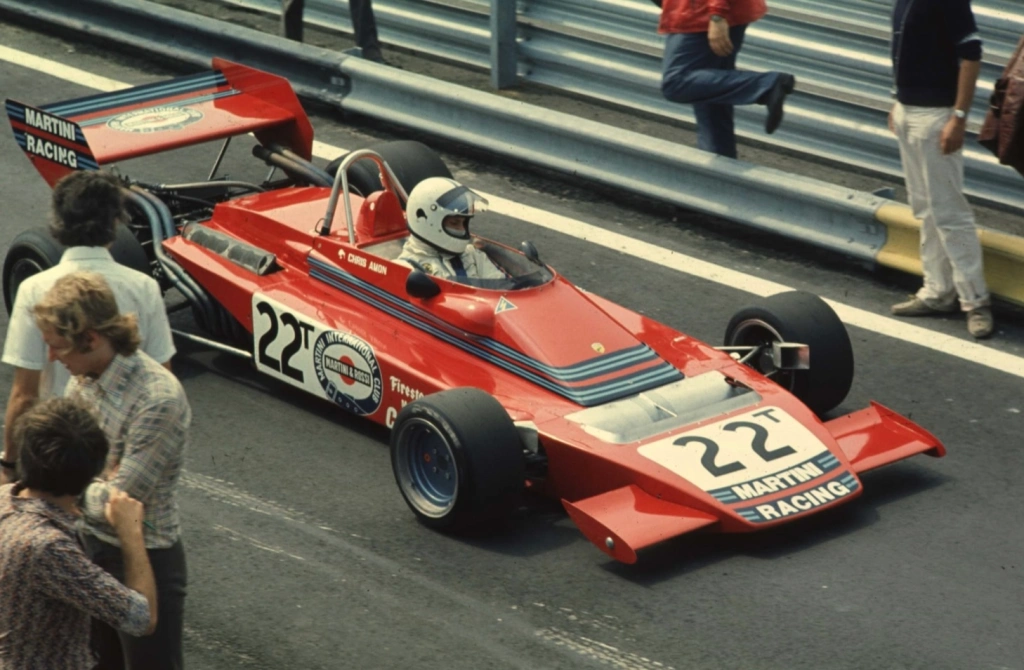
Tecno missed the German GP but rejoined the circus at the Osterreichring for what proved to be their final race, an act of the complete farce.
Pit pundits were amused to see the Tui Tecno arrive in the Tecno transporter and the Goral Tecno on a trailer behind Fowell’s Road car; one-for-all and all-for-one.
Amon qualified the PA123-73 second last on the grid but didn’t take the start. There simply wasn’t a suitable race-engine to install, he departed in disgust and contempt.
And that, sadly, was that.


The Pederzani’s withdrew from racing but continued with their other enterprises. Amon finished the season with a couple of guest drives for Team Tyrrell, albeit his drive at Watkins Glen evaporated after Francois Cevert’s tragic death during practice in a sister car.
Looking back decades later, Amon claimed that Tui Tecno PA123-73 was the better car, but conceded the Goral Tecno didn’t get a fair crack of the whip. “It was a beautiful looking car, but it lacked development” Indeed, given its late arrival the E731’s potential was never unlocked according to those involved.
“Fowell was a clever guy,” says McIntosh, who remained with the designer to work on Amon’s own F1 car the following year; another catastrophic piece of Amon decision making.
Thompson recalls the final Tecno incorporating a host of “different ideas”. It was the first F1 chassis, he claims, to run a fibreglass rear wing.
McCall and McIntosh, from opposite camps, agreed that Luciano Pederzani was a talented engineer. McCall describes the Italian as “a hands-on mechanic and a real smart man”. McIntosh remembers him as “an intuitive engineer”.
MotorSport wrote that “The end appears to have come at Silverstone, and explains why the team ran out of engines two races later. The story below was told to Wies by a Tecno mechanic years later…”
“He told me that a very long top gear was put in our chassis. The idea was to try to make the British (Goral Tecno) car look better than it was.” That might explain why the Tecno did not qualify that weekend.
This makes no sense to me…The Tecnos wouldn’t have had the torque/power to pull a super tall top gear. A short top would have popped engines due to over revs, a tall one? Not so.
“As soon as Luciano found out he went home and said that he would never be seen at a racetrack again.” Work on a flat-eight F1 engine was immediately stopped.”
Luciano Pederzani kept his word right up to his death in his Bologna workshop in January 1987, he never did return to racing. It was very much motor racing’s loss.
Any assessment of Tecno’s considerable achievements should be viewed over a decade, not the much narrower F1 prism of 1972-73.

Etcetera: Tecno PA123/6...

Beautiful fabrication wherever you look. Tubular rocker operating coil-spring Koni damper and lower wishbone. Bodywork is aluminium.

Amon’s car having an engine change at Monaco. Just how low these flat-12s sit in the car – a stressed component as you can see – is shown from this shot. Rear of the 123-73 is the same as 123-72; a design mandatory requested of Alan McCall.


The overhead shot from a Monaco apartment shows the shape of PA123/6 and it’s width. Deformable structures were mandated by the FIA that season, some teams did a better job of integrating them than others.

Note fuel rail and Lucas fuel injection and forward facing roll bar. There is no need to knock the chassis, Amon said it was good.

Flat-12 engine output somewhere north of 420bhp while noting Amon’s view that it felt more like 400, inboard rear discs, Hewland FG400 gearbox,


The far more resolved location of ancillaries of the 1973 PA123 is clear. Note fuel metering unit, electronic ignition box and brake ducts.
Reference and photo credits…
MotorSport Images, Tecno Register, Italiaonroad.it, oldracingcars.com, ‘History of The Grand Prix Car’ Doug Nye, MotorSport, Automobile Year 21
Tailpiece…

Let’s finish where we started with the F1 cars; PA123/1 at Nivelles on debut in 1972. Rainer Schlegelmilch’s typically wonderful arty-farty shot of Nanni Galli during the Belgian GP weekend.
Finito…